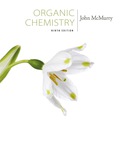
a)

Interpretation:
The terminal alkyne and the alkyl halide from which the compound shown can be obtained are to be shown. If two routes are possible both has to be listed.
Concept introduction:
The alkylation of
To show:
The terminal alkyne and the alkyl halide from which the compound shown can be obtained. Further to list both routes if two routes are possible.
b)

Interpretation:
The terminal alkyne and the alkyl halide from which the compound shown can be obtained are to be shown. If two routes are possible both has to be listed.
Concept introduction:
The alkylation of alkynes is an efficient method for preparing higher alkanes. Acetylene upon alkylation gives a terminal alkyne while further alkylation of a terminal alkyne leads to the formation of an internal alkyne. The actylide anion, being nucleophilic in nature, displaces the halide ion when treated with alkyl halide and gets itself attached to the alkyl group to yield a terminal alkyne. Only primary alkyl halides can be used in the reaction because when secondary and tertiary alkyl halides are used elimination of a hydrogen halide occurs instead of substitution.
To show:
The terminal alkyne and the alkyl halide from which the compound shown can be obtained. Further to list both routes if two routes are possible.
c)

Interpretation:
The terminal alkyne and the alkyl halide from which the compound shown can be obtained are to be shown. If two routes are possible both has to be listed.
Concept introduction:
The alkylation of alkynes is an efficient method for preparing higher alkanes. Acetylene upon alkylation gives a terminal alkyne while further alkylation of a terminal alkyne leads to the formation of an internal alkyne. The actylide anion, being nucleophilic in nature, displaces the halide ion when treated with alkyl halide and gets itself attached to the alkyl group to yield a terminal alkyne. Only primary alkyl halides can be used in the reaction because when secondary and tertiary alkyl halides are used elimination of hydrogen halide occurs instead of substitution.
To show:
The terminal alkyne and the alkyl halide from which the compound shown can be obtained. Further to list both routes if two routes are possible.
Trending nowThis is a popular solution!

Chapter 9 Solutions
EBK ORGANIC CHEMISTRY
- presented by Morallen Lig Intermine the hand product for the given mution by adding atoms, bonds, nonhonding diarion panda скуль Step 3: Comp the draw the product Step 2: Agama workup Compithe 429 ملولةarrow_forwardReaction A 0,0arrow_forwardpresented by Morillon Leaning Predict the organic product for the min кусур HSC Adithane carved arnown to come than that to the condon slchroruis in acid in in aquishri with ноюarrow_forward
- 6.15PM Sun Mar 30 K Draw the major product of this reaction. Include any relevant stereochemistry. Ignore inorganic byproducts. Problem 1 of O H [PhзPCH2CH3]*C|¯ NaH Drawing > Q Atoms, Bonds and Draw or tap a nearrow_forward8:17 PM Sun Mar 30 Draw the major product of this reaction. Ignore inorganic byproducts. HSCH2CH2CH2SH, BF3 Probler Drawing Ato Bonds Clarrow_forwardpresented by Mr L How the coprion. (Il Done in no wraction, dew the starting redential) доarrow_forward
- 8:16 PM Sun Mar 30 K Draw the major product of this reaction. Ignore inorganic byproducts. Proble 1. CH3MgBr 2. H3O+ F Drawingarrow_forwardо но оarrow_forwardName the major organic product of the following action of 4-chloro-4-methyl-1-pentanol in neutral pollution 10+ Now the product. The product has a molecular formula f b. In a singly hain, the starting, material again converts into a secule with the molecular kormula CIO. but with comply Draw the major organic structure inhalationarrow_forward
- Macmillan Learning Alcohols can be oxidized by chromic acid derivatives. One such reagent is pyridinium chlorochromate, (C,H,NH*)(CICTO3), commonly known as PCC. Draw the proposed (neutral) intermediate and the organic product in the oxidation of 1-butanol by PCC when carried out in an anhydrous solvent such as CH₂C₁₂. PCC Intermediate OH CH2Cl2 Draw the intermediate. Select Draw Templates More с H Cr о Product Draw the product. Erase Select Draw Templates More H о Erasearrow_forwardIf I have 1-bromopropene, to obtain compound A, I have to add NaOH and another compound. Indicate which compound that would be. A C6H5 CH3arrow_forwardProvide the reagents for the following reactions.arrow_forward

 Organic Chemistry: A Guided InquiryChemistryISBN:9780618974122Author:Andrei StraumanisPublisher:Cengage Learning
Organic Chemistry: A Guided InquiryChemistryISBN:9780618974122Author:Andrei StraumanisPublisher:Cengage Learning Organic ChemistryChemistryISBN:9781305580350Author:William H. Brown, Brent L. Iverson, Eric Anslyn, Christopher S. FootePublisher:Cengage Learning
Organic ChemistryChemistryISBN:9781305580350Author:William H. Brown, Brent L. Iverson, Eric Anslyn, Christopher S. FootePublisher:Cengage Learning


